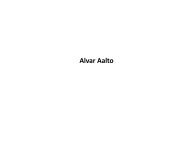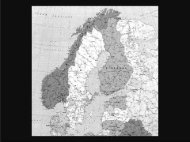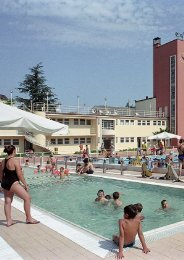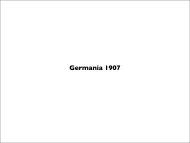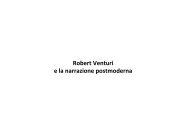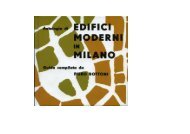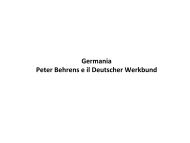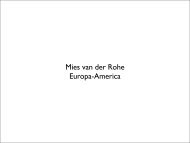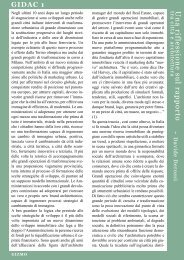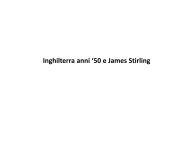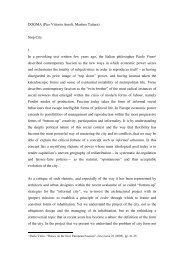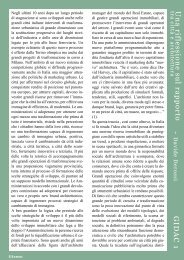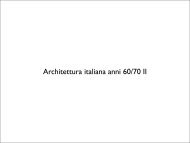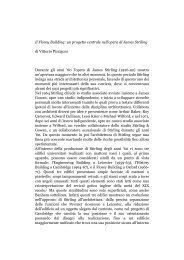ThE nOn- figuraTiVE CiTy - The City as a Project
ThE nOn- figuraTiVE CiTy - The City as a Project
ThE nOn- figuraTiVE CiTy - The City as a Project
You also want an ePaper? Increase the reach of your titles
YUMPU automatically turns print PDFs into web optimized ePapers that Google loves.
Spring 2010 PhD EVENTS<br />
Organized by “<strong>The</strong> <strong>City</strong> <strong>as</strong> a <strong>Project</strong>” PhD program<br />
During the spring of 2010, “<strong>The</strong> <strong>City</strong> <strong>as</strong> a <strong>Project</strong>”<br />
PhD Program will organize a seminar series and<br />
conference under the title “Whatever Happened to the<br />
Twentieth Century: Modernity and Its Discontents.”<br />
<strong>The</strong>se events will reconsider the legacy of the<br />
modern project on the city. <strong>The</strong> intention is to move<br />
away from both the cliché of its interpretation<br />
<strong>as</strong> a totalitarian project and from its nostalgic<br />
recuperation <strong>as</strong> utopian imaginary. Each seminar<br />
will focus on a specific theme that rethinks one of<br />
the most radical, controversial—and even sometimes<br />
politically incorrect—projects of modernity in light<br />
of the current imp<strong>as</strong>se of postmodern theories on the<br />
city. A one-day conference will also be held on the<br />
urban projects and theories of Ludwig Hilberseimer.<br />
SEMINARS<br />
Thursday, 28 January<br />
Modern Architecture and<br />
the Construction of the<br />
Welfare State<br />
Sven-Olov Wallenstein, lecturer,<br />
Södertörn University and Royal<br />
Institutute of Technology,<br />
Stockholm<br />
Thursday, 18 March<br />
Architecture and Revolution:<br />
Le Corbusier,<br />
Politics and Architecture<br />
1930–1942<br />
Mary McLeod, Professor of<br />
Architecture, Columbia University,<br />
New York<br />
Thursday, 8 April<br />
Manfredo Tafuri and the<br />
Avant-garde: Closereading<br />
<strong>The</strong> Sphere and<br />
the Labyrinth<br />
Joan Ockman, architectural<br />
historian and critic, New York<br />
Thursday, 20 May<br />
On the Ruins of the<br />
Post-Fordist <strong>City</strong><br />
Matteo P<strong>as</strong>quinelli, writer and<br />
critic, Amsterdam<br />
CONFERENCE<br />
Friday, 19 March<br />
<strong>The</strong> non-figurative<br />
<strong>City</strong>:Rethinking the<br />
Legacy of Ludwig<br />
Hilberseimer<br />
Pier Vittorio Aureli; Andrea Branzi;<br />
Markus Kilian; Gabriele M<strong>as</strong>trigli;<br />
Philippe Morel; Albert Pope;<br />
Martino Tattara; and Charles<br />
Waldheim<br />
Thursday, 15 April<br />
Formalities<br />
Lucia Allais, Lecturer in<br />
Architecture and in the Humanities,<br />
Princeton University<br />
Ludwig Hilberseimer, project for Marquette Park, Chicago, 1955<br />
Ludwig Hilberseimer, design for a high-rise city, 1924<br />
DESIGN: LUST, THE HAGUE<br />
Berlage Institute<br />
Botersloot 25<br />
3011 HE Rotterdam<br />
<strong>The</strong> Netherlands<br />
T. +31.10.4030399<br />
www.berlage-institute.nl<br />
Friday, 19 March 2010 Berlage Institute<br />
10:00 am—6:00 pm<br />
<strong>The</strong> nonfigurative<br />
<strong>City</strong>:<br />
Rethinking<br />
the Legacy<br />
of Ludwig<br />
Hilberseimer<br />
Spring 2010 PhD EVENTS<br />
Whatever Happened to the Twentieth Century:<br />
Modernity and Its Discontents<br />
organized by “<strong>The</strong> <strong>City</strong> <strong>as</strong> a <strong>Project</strong>” PhD program<br />
Ludwig Hilberseimer, perspective of entry for Chicago Tribune Competition, 1922<br />
Ludwig Hilberseimer standing before a tower composed from his Welfare <strong>City</strong> model, 1927<br />
Friday, 19 March 2010<br />
Berlage Institute<br />
10:00 am—6:00 pm<br />
<strong>The</strong> nonfigurative<br />
<strong>City</strong>:<br />
Rethinking<br />
the Legacy<br />
of Ludwig<br />
Hilberseimer<br />
<strong>The</strong> Berlage Institute in Rotterdam will<br />
present a one-day conference, entitled<br />
“<strong>The</strong> Non-Figurative <strong>City</strong>: Rethinking<br />
the Legacy of Ludwig Hilberseimer,”<br />
to take place on Friday, 19 March 2010<br />
from 10:00 am to 6:00 pm. <strong>The</strong> conference<br />
aims to rethink the legacy of<br />
the architect, theorist, and urban planner<br />
Ludwig Hilberseimer. Conference<br />
participants will retrace his projects<br />
and theories on the city through new<br />
and innovative interpretations that situate<br />
his work in light of contemporary<br />
urban problems.<br />
<strong>The</strong> contribution of Hilberseimer to<br />
the debate on the modern metropolis<br />
remains one of the most extreme, if<br />
not one of the most original. His work<br />
addressed the city, whose project he<br />
reduced to minimal structuring principles<br />
or what could be described <strong>as</strong><br />
a “non-figurative approach.” That<br />
is, an architecture without attributes,<br />
which, for this re<strong>as</strong>on, is able to overcome<br />
its formal crisis and reclaim<br />
itself an instrument of urban and political<br />
invention.<br />
A reluctant builder and prolific planner,<br />
Hilberseimer wrote several significant<br />
books, including Grosstadtarchitektur<br />
[<strong>The</strong> Architecture of the Big <strong>City</strong>] published<br />
in 1927; and realized, together<br />
with his close friend Ludwig Mies van<br />
der Rohe, Lafayette Park in Detroit,<br />
one of the most impressive and highly<br />
praised housing developments of<br />
the postwar period. Yet his austere<br />
planning schemes have often been<br />
dismissed <strong>as</strong> reductive, the embodiment<br />
of modernist alienation. His rich<br />
corpus of theoretical writings h<strong>as</strong> not<br />
yet attracted the degree of attention<br />
devoted to other prolific theorists of<br />
his time.<br />
In spite of such limited critical acclaim,<br />
Hilberseimer’s work h<strong>as</strong> inspired<br />
important and radically different—if<br />
not at times opposing—interpretations<br />
of the city and its project, a few examples<br />
include: Manfredo Tafuri’s critique<br />
of architectural ideology, Archizoom’s<br />
zero degree urbanism, Rem Koolha<strong>as</strong>’s<br />
notion of Nothingness, K. Michael<br />
Hays’s analysis of the post-humanist<br />
subject in architecture, Charles<br />
Waldheim’s research on landscape<br />
urbanism, Albert Pope’s studies on the<br />
ladder urbanism of North American<br />
cities, and Philippe Morell’s inquiries<br />
on architecture in the Age of Integral<br />
Capitalism.<br />
<strong>The</strong> conference, organized <strong>as</strong> part of<br />
“<strong>The</strong> <strong>City</strong> <strong>as</strong> a <strong>Project</strong>” PhD Program,<br />
will map the original and unexpected<br />
ways in which Hilberseimer’s work<br />
and theories anticipate (seemingly)<br />
opposed contemporary urban paradigms,<br />
such <strong>as</strong> the generic city and the<br />
emergence of ecological urbanism.<br />
His view of the structuring role of<br />
landscape and territory in the formation<br />
of cities may be linked to the<br />
emergence of the post-humanist subject<br />
and the possibility of a non-figurative<br />
architecture. <strong>The</strong> main challenge of the<br />
conference will be to rethink the meaning<br />
of Hilberseimer’s radical approach<br />
to architecture and the city in relation<br />
to the role of welfare, infr<strong>as</strong>tructure,<br />
large-scale design of cities, and the<br />
emergence and crisis of twentiethcentury<br />
forms of urbanization.<br />
Presentations by:<br />
Pier Vittorio Aureli<br />
Head of “<strong>The</strong> <strong>City</strong> <strong>as</strong> a <strong>Project</strong>” PhD Program,<br />
Berlage Institute, Rotterdam<br />
Andrea Branzi<br />
Professor of Industrial Design,<br />
Politecnico di Milano<br />
Markus Kilian<br />
Partner, V-architects, Cologne<br />
Gabriele M<strong>as</strong>trigli<br />
Architecture critic, Rome<br />
Philippe Morel<br />
Partner, EZCT Architecture & Design Research,<br />
Paris<br />
Albert Pope<br />
Gus Sessions Wortham Professor of Architecture,<br />
Rice University, Houston<br />
Martino Tattara<br />
Visiting first-year postgraduate tutor,<br />
Berlage Institute, Rotterdam<br />
Charles Waldheim<br />
Professor and Chair of Landscape Architecture,<br />
Graduate School of Design, Harvard University<br />
ABOUT “<strong>The</strong> <strong>City</strong> As A <strong>Project</strong>” PhD Program<br />
“<strong>The</strong> <strong>City</strong> <strong>as</strong> a <strong>Project</strong> PhD<br />
Program,” launched during<br />
the 2009–2010 year, is<br />
conceptualized to understand<br />
the city’s form <strong>as</strong> an act that<br />
defines a political intentionality.<br />
Thus establishing a precondition<br />
for engagement<br />
with the city’s complex<br />
nature. A fundamental issue<br />
at stake is form in relation to<br />
the political. <strong>The</strong> term “city”<br />
is defined not <strong>as</strong> a mere m<strong>as</strong>s<br />
of flows and programs but <strong>as</strong><br />
a political form. <strong>The</strong> terms<br />
political and form are<br />
<strong>as</strong>sumed to be the fundamental<br />
criteria that construct the<br />
essence of the city. If the<br />
essence of political action is<br />
the attempt to project a form<br />
of coexistence among individuals,<br />
it may be said that<br />
architectural form inevitably<br />
implies a political vision.<br />
Even if there is no political<br />
architecture, there is certainly<br />
a political way of making and<br />
reading architectural form.<br />
Far from being just an aesthetic<br />
category, physical form<br />
represents the political understanding<br />
of the city <strong>as</strong> a constant<br />
dialectic process of<br />
inclusion and exclusion. This<br />
commitment to formal and<br />
material responsibility is<br />
meant to be a departure from<br />
the laissez-faire rhetoric of<br />
flexibility and indeterminacy<br />
that h<strong>as</strong> paralyzed recent discussion<br />
on the city.<br />
<strong>The</strong> three-year program, headed<br />
by Pier Vittorio Aureli, is<br />
organized and structured <strong>as</strong><br />
a critical forum where participants<br />
are <strong>as</strong>ked not only to<br />
pursue their individual studies<br />
but also to share these<br />
studies <strong>as</strong> part of a collective<br />
debate. Candidates are not<br />
full time, but required to take<br />
part in all these events.<br />
Participation consists of individual<br />
tutorials with the<br />
supervisor, monthly seminars<br />
with invited guest scholars, a<br />
yearly international colloquium,<br />
and symposia.<br />
<strong>The</strong>se activities are venues for<br />
discussion and constitute<br />
occ<strong>as</strong>ions for candidates to<br />
deliver content related to his<br />
or her thesis in the form of<br />
presentations, papers, and<br />
publishable essays.
A ONE-DAY CONFERENCE<br />
FRIDAY, 19 march 2010<br />
10:00 am—6:00 pm<br />
<strong>The</strong><br />
www.berlage-institute.nl Free and open to the public<br />
For more information, ple<strong>as</strong>e see<br />
www.berlage-institute.nl/events<br />
THE NON-FIGURATIVE CITY:<br />
Rethinking the Legacy of<br />
Ludwig Hilberseimer<br />
BERLAGE INSTITUTE<br />
Botersloot 25<br />
ROTTERDAM, <strong>The</strong> netherlands<br />
<strong>City</strong>Archizoom Associati, proposal for a homogeneous residential plot system from No Stop <strong>City</strong>, 1969<br />
Presentations by:<br />
Pier Vittorio Aureli<br />
Andrea Branzi<br />
Markus Kilian<br />
Gabriele M<strong>as</strong>trigli<br />
Philippe Morel<br />
Albert Pope<br />
Martino Tattara<br />
Charles Waldheim<br />
Rethinking the<br />
Legacy of Ludwig<br />
Hilberseimer<br />
organized by<br />
“<strong>The</strong> <strong>City</strong> <strong>as</strong> a <strong>Project</strong>” PhD Program



